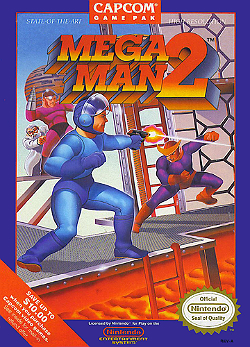
Mega Man 2 is an action game developed and published by Capcom for the Nintendo Entertainment System. It was released in Japan in 1988 and in North America and PAL regions the following years. Mega Man 2 continues Mega Man's battle against the evil Dr. Wily and his rogue robots. It introduced graphical and gameplay changes, many of which became series staples.
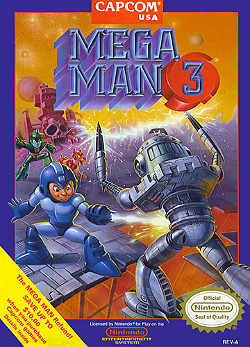
Mega Man 3 is an action-platform video game developed and published by Capcom for the Nintendo Entertainment System. It is the third game of the original Mega Man series and was originally released in Japan on September 28, 1990. The game was released in North America later in 1990 and in European regions by Nintendo in 1992. Taking place after the events of Mega Man 2, the plot follows the titular hero as he helps his creator, Dr. Light, and a supposedly former enemy, Dr. Wily, collect parts for a peace-keeping robot by defeating several Robot Masters that have gone haywire.
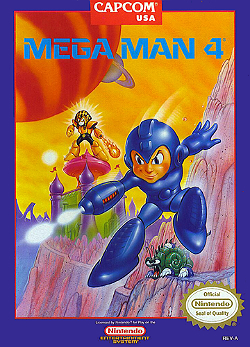
Mega Man 4 is an action-platform game developed by Capcom for the Nintendo Entertainment System. It is the fourth game in the original Mega Man series and was originally released in Japan in 1991. The game was localized in North America the following January, and in Europe in 1993.

Mega Man 5 is an action-platform video game developed by Capcom for the Nintendo Entertainment System. It is the fifth game in the original Mega Man series and was released in Japan on December 4, 1992. It saw a release during the same month in North America and in 1993 in Europe.

Mega Man & Bass is an action-platform video game developed and published by Capcom. It is a spin-off game in the original Mega Man series and was originally released in Japan for the Super Famicom on April 24, 1998. It was later ported to the Game Boy Advance (GBA) handheld in 2002, and localized in English and released the following year.

Doctor Albert W. Wily is a video game character and the main antagonist of the original Mega Man series, as well as Mega Man's archenemy and is also the creator of Bass and Zero. He appeared in the first Mega Man video game and later in promotions and other media related to the series. In Japanese, he is voiced by Takeshi Aono in all appearances except Mega Man: The Power Battle and its sequel, as well as Mega Man: Upon a Star, where he instead was voiced by Kenichi Ogata; in English, the character is voiced by Douglas Kendall, Dean Galloway, Keith Silverstein, Ian James Corlett, and Scott McNeil voicing the character in Mega Man 8, Mega Man Powered Up, Mega Man 11, Captain N: The Game Master, and the animated series, respectively.

Mega Man 8 is a platform game developed and released by Capcom in 1996. It was directed by Hayato Kaji and produced by Keiji Inafune, both of whom had previously worked on the series as artists. It is the eighth installment in the original Mega Man series, and was initially released in Japan on the PlayStation in 1996. The following year, Mega Man 8 saw a release on the Sega Saturn and was localized for both consoles in North America and the PlayStation alone in PAL regions. Mega Man 8 is the first game in the series made available on 32-bit consoles. The plot follows series protagonist Mega Man as he is called to investigate an energy reading coming from a recent meteor crash on an island. Mega Man discovers that his nemesis Dr. Wily has run off with the energy source, and sets off to stop Wily's evil plans to use the energy, and to discover the purpose of a mysterious alien robot found at the crash site.
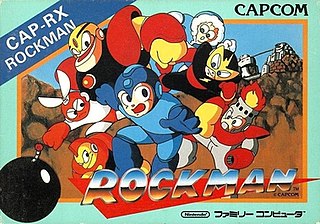
Mega Man, known as Rockman in Japan, is a platform game developed and published by Capcom in 1987 for the Nintendo Entertainment System. It was directed by Akira Kitamura, with Nobuyuki Matsushima as lead programmer, and is the first game of the Mega Man franchise and the original video game series. Mega Man was produced by a small team specifically for the home console market, a first for Capcom, which previously focused on arcade video games.
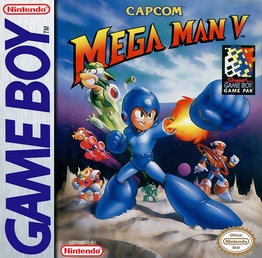
Mega Man V is a video game published by Capcom for the Game Boy handheld game console. It is the fifth game in the Game Boy version of the original Mega Man series. The game follows the adventures of the protagonist Mega Man as he must defend the Earth from a group of powerful robots from outer space called the Stardroids. Mega Man V is unique among the Game Boy Mega Man games as it features original bosses rather than recycling those from the Nintendo Entertainment System (NES) Mega Man games.

Mega Man X is a platform game developed and published by Capcom for the Super Nintendo Entertainment System. It was the first Mega Man game for the 16-bit console and the first game in the Mega Man X series, a spin-off to the original Mega Man series that began on the Super NES's predecessor, the Nintendo Entertainment System. Mega Man X was released in Japan on December 17, 1993 and was released in both North America and Europe the following year. Taking place a century after the original Mega Man series, Mega Man X is set in a futuristic world populated by both humans and "Reploids", robots capable of thinking, feeling, and growing like their human creators. Because of these complex attributes, many Reploids are prone to destructive, renegade activity and are thereafter referred to as "Mavericks". The plot of the game follows the protagonist X, an android member of a military task force called the "Maverick Hunters". With the help of his partner Zero, X must thwart the plans of Sigma, a powerful Maverick leader wishing to bring about human extinction.

Mega Man Battle Network is a role-playing video game developed by Capcom for the Game Boy Advance (GBA) handheld console. It is the first title of the Mega Man Battle Network series of games. It was originally released in Japan as a GBA launch game on March 21, 2001 and was released later that year in North America and Europe. It was also released via the Wii U Virtual Console in Japan on July 9, 2014, in Europe on July 24, 2014, and in North America on July 31, 2014.
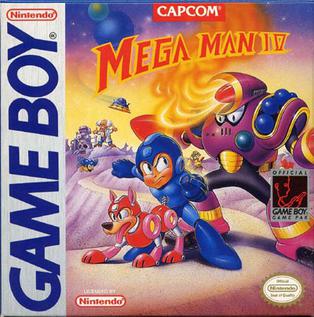
Mega Man IV is an action-platform video game by Capcom for the Nintendo Game Boy. It is the fourth installment in the handheld version of the Mega Man series. The game continues the quest of the protagonist Mega Man in the struggle with his long-time nemesis Dr. Wily, who sends out a disruptive radio signal to cause a rampage, citywide destruction from dormant robots. Mega Man IV features the traditional action platforming gameplay of the prior games while introducing one new feature, the ability to purchase items with power-ups found throughout each stage. As with previous Game Boy releases, the game incorporates gameplay elements and bosses from two sequential Nintendo Entertainment System (NES) games: Mega Man 4 and Mega Man 5. The game has received a warm critical reception. In 2013, Mega Man IV was made available on the Virtual Console of Japan's Nintendo eShop for the Nintendo 3DS. It was later released in the North American and PAL region eShops the following year.
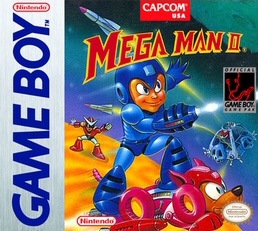
Mega Man II is an action-platform video game by Capcom for the Game Boy. It is the second game in the handheld version of the Mega Man series after Mega Man: Dr. Wily's Revenge. It is noteworthy for having been developed by a different company than the rest of the Mega Man titles on the Game Boy.

Mega Man: Dr. Wily's Revenge, also known as Mega Man in Dr. Wily's Revenge or in Japan as Rockman World is an action-platform video game by Capcom for the Nintendo Game Boy. It is the first game in the handheld series of the Mega Man franchise. It was released in Japan on July 26, 1991, and was localized in North America that December and in Europe the following year. The game continues the adventures of the android hero Mega Man as he once again confronts the evil Dr. Wily, who has dispatched his revived "Robot Masters" and a new "Mega Man Killer" named Enker.

Mega Man X is a series of action platform games released by Capcom. It is a sub-series of the Mega Man franchise previously developed by the same group with Keiji Inafune acting as one of the main staff members. The first game was released on 17 December 1993 in Japan on the Super Famicom and the following month on the Super NES in North America. Most of the sequels were ported to Microsoft Windows. The gameplay introduces new elements to the Mega Man franchise in the form of Mega Man's successor X including his new skills and power ups in the form of armors while retaining the decision to decide which boss fight first. The first six games in the series were compiled in the anthology Mega Man X Collection and then the Legacy duology collected the entire eight main games.

Mega Man 9 is a 2008 action-platform video game developed by Capcom and Inti Creates. It is the ninth numbered game in the original Mega Man series, and the first home console game in the series since Mega Man & Bass (1998). Mega Man 9 was the first game in the series not to have a physical release, and was initially released only on the downloadable gaming services WiiWare, PlayStation Network (PSN), and Xbox Live Arcade (XBLA). In June 2017, it was announced that Mega Man 9 and 10 would have a physical and digital release with their inclusion in Mega Man Legacy Collection 2 for PlayStation 4, Windows, and Xbox One, as well as the Nintendo Switch in May 2018.

Mega Man 6, known in Japan as Rockman 6: The Greatest Battle in History!!, is an action-platform video game developed by Capcom for the Nintendo Entertainment System. It is the sixth installment in the original Mega Man series. It was originally released in Japan by Capcom in 1993, and in North America by Nintendo in 1994. It was included in the Mega Man Anniversary Collection released in 2004. Its first release in Europe and PAL region was June 11, 2013, for the 3DS Virtual Console, nearly twenty years after the game's initial release.

Mega Man, known as Rockman in Japan, is the title character and the protagonist of the Mega Man series by Capcom. He was created by Akira Kitamura for the first Mega Man game released in 1987, with artist Keiji Inafune providing detailed character artwork based on Kitamura's pixel art design.

Mega Man 7 is an action platform video game developed and published by Capcom for the Super Nintendo Entertainment System. It is the seventh game in the original Mega Man series. The game was released in Japan on March 24, 1995 and was localized later in the year in North America and Europe.




















